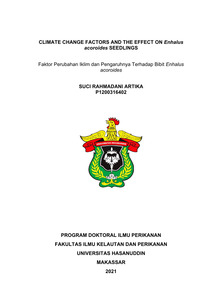Artika, Suci Rahmadani (2021) Faktor Perubahan Iklim dan Pengaruhnya Terhadap Bibit Enhalus acoroides. Disertasi thesis, Universitas Hasanuddin.
![[thumbnail of Cover]](/12097/1.hassmallThumbnailVersion/P1200316402_disertasi_05-11-2021%20cover1.png)

P1200316402_disertasi_05-11-2021 cover1.png
Download (248kB) | Preview
P1200316402_disertasi_05-11-2021 1-2.pdf
Download (1MB)
P1200316402_disertasi_05-11-2021 dp.pdf
Restricted to Repository staff only
Download (179kB)
P1200316402_disertasi_05-11-2021 dp.pdf
Download (179kB)
Abstract (Abstrak)
Climate change encompasses both global warming caused by human-caused greenhouse gas pollution and the subsequent large-scale weather pattern changes. Though there have been past cycles of climatic change, humans have had a genuine effect on Earth's climate system and induced environmental change since the mid-20th century. Climate change does not only affect human life but also other living things. It does not only affect areas on land, but also in waters, for example the seagrass ecosystem. Seagrasses form a seagrass bed, which is an aquatic ecosystem. Seagrasses are saltwater aquatic plants that can be found in shallow coastal waters and brackish estuarine waters. Seagrasses are flowering plants with long, grass-like stems and leaves. They have roots and rhizomes that anchor them in the sand on the seafloor, and they contain seeds and pollen. In Indonesia, as a tropical country, it has 12 types of seagrasses, one of which is Enhalus acoroides. Enhalus acoroides adults are quite resistant to environmental changes, but this does not necessarily apply to it seedlings.
By using field and laboratory experimental methods, the research wanted to prove how the influence of the factors of climate change (increased temperature and increased CO2) on seedling Enhalus acoroides. Not only that, but this study also looked at the indirect impact of climate change (nutrient enrichment and heat-wave) on seedling Enhalus acoroides.
The results showed that climate change, through simple experiments, temperature increase and CO enrichment as well as nutrient and heat-wave enrichment had a direct and indirect impact on Enhalus acoroides. Directly, through increasing temperatures and heat-wave scenarios, climate change affects the metabolism of Enhalus acoroides seedling so that it can accelerate its growth rate. Indirectly, through CO2 enrichment and nutrient enrichment, climate change can affect the ecosystem around Enhalus acoroides which can then disrupt the survival of Enhalus acoroides. This is related to the ability of photosynthesis and seagrass to compete with other organisms, such as epiphytes.
Ultimately, climate change could have had a greater effect on Enhalus acoroides if it had been exposed to it for longer. The lack of research on this topic is also the reason for the need for further and in-depth research related to climate change and its effects on Enhalus acoroides, especially in the seedling phase.
| Item Type: | Thesis (Disertasi) |
|---|---|
| Uncontrolled Keywords: | Climate Change, Enhalus acoroides, Seedling, Perubahan Iklim, Seagrass |
| Subjects: | H Social Sciences > H Social Sciences (General) |
| Depositing User: | Andi Milu |
| Date Deposited: | 28 Dec 2021 06:42 |
| Last Modified: | 28 Dec 2021 06:42 |
| URI: | http://repository.unhas.ac.id:443/id/eprint/12097 |


